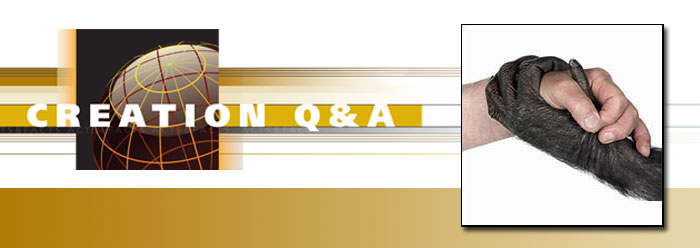For the past several decades, the standard mantra has been that humans are 98 percent genetically identical to chimpanzees. However, this claim is based on cherry-picked data and does not take into account the vastly different regions of the two respective genomes.
Major research published over the past decade comparing human and chimpanzee DNA was recently reviewed and critiqued.1 In every single publication, researchers only reported on the highly similar DNA sequence data and discarded the rest—apparently because it was too dissimilar. In fact, when the DNA similarities from these studies were recalculated using the omitted data, markedly lower levels—between 81 and 86 percent similarity—were found. Even the well-known chimpanzee genome paper published by evolutionists in 2005 provides a genomic similarity of only about 80 percent when the discarded nonsimilar data are included and only 70 percent when the estimated size of the chimpanzee genome is incorporated.2,3
In 2011, I tested a wide variety of DNA alignment parameters for 40,000 segments of chimpanzee DNA that were already known to be similar to human. The parameters that gave the longest DNA alignment matches produced 86 percent similarity.3 Another interesting outcome from this study was that the 740-base-long chimp DNA sequences became too different to align after just a few hundred bases, on average.
Clearly, a more informative technique was needed to accurately compare the entire chimp genome to that of humans—specifically, something that counteracted the problem of the algorithm breaking off the match in regions of low similarity. By digitally slicing entire chimp chromosomes into small pieces, I found that the algorithm could effectively compare chimp and human DNA piece-by-piece.3 This involved doing multiple experiments to find the optimal DNA sequence lengths, or “slices,” to fully ascertain the average overall similarity for each chimp chromosome when compared to its alleged human counterpart.
Not counting the Y-chromosome, the results of my comparison showed variability between 66 and 76 percent similarity for the different chimp chromosomes, with an overall genome average of only 70 percent similarity to human chromosomes. In reality, many chromosomal regions are vastly different between chimps and humans, and several areas of the genome that are present in chimps are completely absent in humans—and vice versa.
While it is true that there are sections of the chimp genome that are very similar to humans, this is not the complete picture. DNA sequence comparisons that include all the relevant data plainly show that the human and chimp genomes are not nearly identical at all. Instead, they are as distinct as one might expect based on the obvious differences in the resulting anatomies and behavioral capacities.
Hypothetical evolutionary processes cannot explain the extremely broad differences between chimp and human DNA when the whole genomes are considered. The similar regions between genomes are easily interpreted as the basic reuse of effective code—a concept very familiar to software engineers. Such evidence points to a Master Designer who has orchestrated all the wondrous diversity of life on Earth after its own kind.
References
- Tomkins, J. and J. Bergman. 2012. Genomic monkey business—estimates of nearly identical human-chimp DNA similarity re-evaluated using omitted data. Journal of Creation. 26 (1): 94-100.
- Tomkins, J. 2013. Comprehensive Analysis of Chimpanzee and Human Chromosomes Reveals Average DNA Similarity of 70%. Answers Research Journal. 6: 63-69.
- Tomkins, J. 2011. Genome-Wide DNA Alignment Similarity (Identity) for 40,000 Chimpanzee DNA Sequences Queried against the Human Genome is 86–89%. Answers Research Journal. 4: 233- 241.
* Dr. Tomkins is Research Associate at the Institute for Creation Research and received his Ph.D. in genetics from Clemson University.














